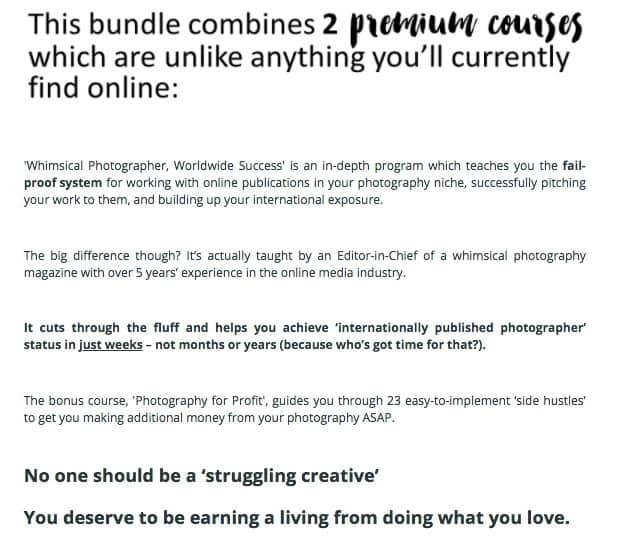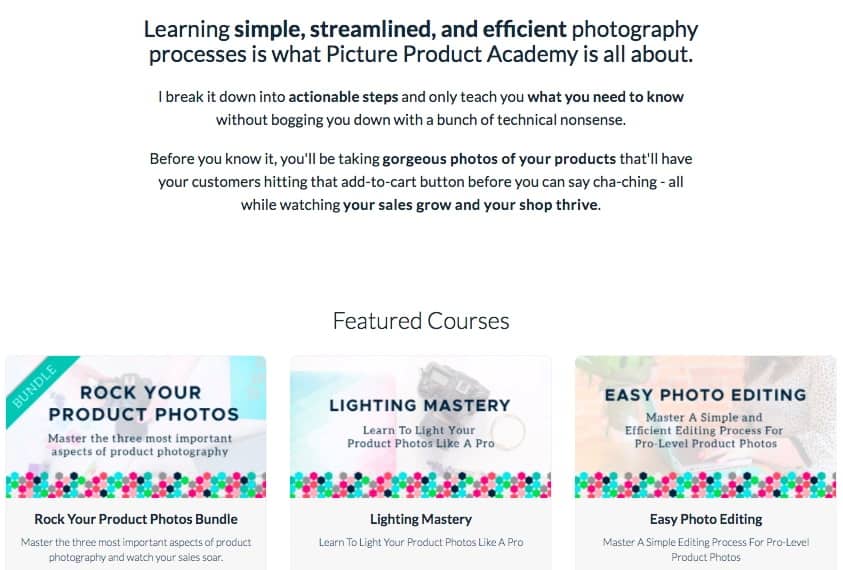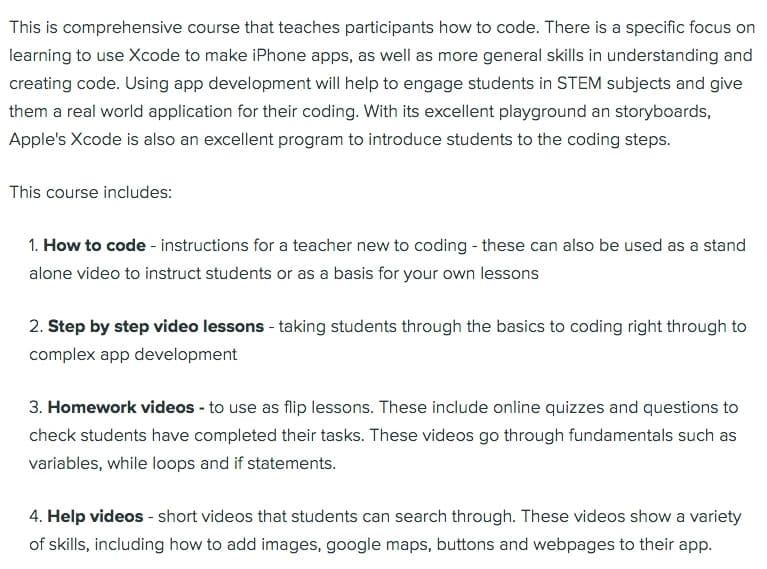How to convey the value of your online course


When you’re creating your online course, you know deep down that what you’ve made is valuable and can really help your audience.
Convincing them of that fact can be a bit more of a battle.
In some niches, people are excited and eager to buy every online course that pops up.
Other niches are a little more difficult to win over.
In some fields, online courses are still uncommon enough that people don’t quite “get” them. They don’t understand their purpose or their value. If you’re in a niche where people are more primed to buy ebooks or downloadables than full courses, conveying the value of your online course is just an added hurdle in your journey, but one that you can easily overcome.
If you’re worried about how to convey the value of your online course to your audience, start by implementing some of the tips in this post.
What you’ll learn in this blog post
-
Why online courses are valuable
-
How online courses save students time and money
-
Why online courses are one of the most flexible forms of education
-
Why online courses are great for continuing education
-
How to convey these benefits to your audience
Why online courses are valuable
It can be intimidating to try to explain the value of an online course to a skeptical customer. You know in your heart that what you’ve created has value, but figuring out the right words to convey that doesn’t come easily to everyone.
My recommendation is to break it down and explain it to them in terms of traditional education.
People gladly spend tens of thousands of dollars on college classes every year. But the world of education is shifting.
All of the sudden, a college degree isn’t always the same golden ticket to a career that it used to be, and a lot of self-educated people are skyrocketing to success through online learning alone.
Whether that’s through their own research or online courses, the internet is changing the way that we see education.
At this point, we can learn virtually anything online, and people are creating their own carefully crafted curriculums to master their field without going into debt for a college degree.
And people can take online courses for reasons other than furthering their careers, too. On Teachable, we’ve seen successful online courses on topics from watercolor painting to free diving to dog walking. If someone is looking to learn anything at all, chance are, there’s a course for it.
Online courses contain all of the same information that an in-person class would, the only difference is that all instruction takes place via the internet. So instead of going to a college classroom to learn about coding, or a cafe to attend a hand lettering workshop, students can learn from the comfort of their home.
The instructors have a lot of control over the online course experience, too. A sample scenario would look like this:
An instructor would open their online course for enrollment and students would sign up. This instructor has opted to “drip” their content, meaning that each week their students would get a set amount of lesson material for the duration of the course. There are interactive comment pages, quizzes, and even a Facebook group where the students can go to connect and find support. Every Tuesday the instructor goes live for an hour hosting a Q&A so students can get their most pressing questions answered.
The online structure parallels that of a classroom, but takes the physical requirement out of education making the class more accessible for everyone. When teaching a physical class you may be able to reach a handful of people – in some cases a few hundred, in rarer cases a few thousand. When you’re teaching an online class, though, your lessons can reach anyone anywhere in the world without limits.
All you have to do is convince them that your online course is worth their investment. The key there, is learning how to convey what you likely already know.
Online courses save students time and money
The truth is, people are constantly craving knowledge. We want to continue learning and growing and evolving and the easiest way to do that is through education.
Now, most of us don’t have the time or money to sign up for college classes at local universities every time we want to learn something new, and even if we did we don’t have the time or freedom while we work our 9-5’s.
But that doesn’t have to stand in the way of you and your education.
Through online courses, you can learn virtually anything that you’d be able to learn in college and courses are usually cheaper and you’re able to learn on your own timetable.
How to convey this to your audience
My favorite way to convey the time and money saving convenience of online courses is through a very cut and dry approach.
Let’s pretend you majored in photography in college and now you’re teaching a photography course. Let your audience know that you spent 6 years prior to college and 4 years in college perfecting your art and near $100,000 in tuition. And now you’re sharing every single one of your most used tips and techniques in your online course that will take them just 14 days to get through and cost $500 to buy.


Melanie from Whim Magazine does a great job showing how her online courses will help her students gain skills while saving time.
Online courses are flexible
I dream of one day having the time and money to buy an online course on every single thing that interests me. I’d spend my days learning about filmography and gardening and cooking and psychology and creating the perfect curriculum customized to every single one of my interests.
In college, I was required to take a ton of classes that I wasn’t interested in and weren’t relevant to my future goals. My advisor said it was to make me a more well rounded student, but when that came at the cost of thousands of dollars, it was a tough pill to swallow.
Through online courses, you can build a curriculum that accomplished exactly what you want it to. You can buy the courses that excite you and learn about whatever it is you’re most interested in.
With traditional education, it’s easy to lose enthusiasm when you’re going to classes that you find dull and don’t align with any of your goals, but when you build your own curriculum through online courses, you know that you’re learning exactly what you want to.
How to convey this to your audience
Sticking with the photography example, let your audience know that you took all of the sculpture and fine art classes. You’ve learned how those concepts can apply to photography and you’ve condensed those ideas into a single lesson.
While they can only benefit from learning about and appreciating other forms of art, that’s something they can do on their own time, and you can guide them through the big takeaways.
Through your online course, they’re getting a university quality education without having to pay for the gen-eds that don’t excite them.


Amy Eaton does a great job using benefit driven language to convey the value of her online courses. She ensures students that they won’t get “bogged down” with needless information.
Online courses are great for continuing education
A college education is so valuable and can open so many doors. But for most people that education takes four years to earn and after that they move on to the next chapter of their lives.
As time goes on, they forget more and more of what they learned in class, and as they fall into the routine of their career it’s easy to begin to lost the information they don’t use on an everyday basis.
Online courses can help you retain what you’ve learned and also further your education. If you’re somebody who fancies themselves as a lifelong learner and wants to continue expanding their knowledge and education, online courses are a great way to do so.
This is especially true if you got your education in a quickly evolving industry. Whether that’s programming or primary education or something in between, new techniques and strategies will constantly be emerging, and it’s important to stay on top of them.
How to convey this to your audience
Here you can really appeal to the practical side of continuing your education. Phrases like, “Worried you’ve forgotten more than what you remember from college?” or “Is your education slowly starting to fade?”
Transition then to “stay up to date on the ever evolving strategies in your industry through taking online courses.”
Of course, this angle isn’t right for every single online course, but if someone can major or minor in your niche, it’s an interesting strategy to consider.


Glenn Carmichael teaches an online course on developing iPhone apps. Something that didn’t even exist fifteen years ago. For programmers who graduated in the nineties or early two thousands, courses like Glenn’s can help keep them up to date with the newest trends.
Online courses are entertaining
So your online course isn’t necessarily going to help anyone land a job or feel like they’re getting a college education. Perhaps you’re teaching someone how to hand carve their own canoe or make healthy meals in 20 minutes a night.
The angle you’ll want to take is your course will improve the quality of your students’ lives. Whether that’s through teaching them a fun new skill they’d be hard pressed to learn anywhere else, or solving an annoying pain point that comes up over and over again.
People don’t always take online courses to master a really technical skill or feel like they’re a student again. Sometimes people just want a single problem solved or want to dive into a fun new hobby.
How to convey this to your audience
Here you really want to focus on specific pain points. If your online course teaches people how to lessen their arthritis symptoms through diet changes, appeal to what people are missing out on when they give into their arthritis.
Share an anecdote about how you used to love to paint until your arthritis got too bad to hold a paintbrush. Even if your audience didn’t have that specific interest, they’ll be able to relate in some way.
Segway into a story about how you decided to take control and get your arthritis under control through changes in your diet. You researched for months, went through the trial and error, and figured out what works. And now you want to share everything that you learned with your audience.
You can also use fun as the main motivator to get people to buy. Let them know that your online course will teach them a lifelong skill that they can pick up whenever they’re bored. For example, if you’re teaching crochet, talk about all of the still moments in their life when they’re just waiting.
“Commuting for 75 minutes a day is enough to drive anyone crazy, but what if you could make productive use of that time? By the end of each week, you have enough time to create beautiful afghans, hats, scarves, and more with just a hook and some yarn. Take control of your commute and use that time to create.”


Amy Phipps teaches people the basics of crochet so they can expand their skills and begin to create beautiful projects.
Using benefit driven language
No matter what angle you’re taking in your sales pitch, one important thing to keep in mind is the strategic use of benefit driven language.
Benefit driven language presents your course to your audience in a way that appeals to them and their needs.
Instead of saying, “I’m giving you 5 hours worth of content that I spent 2 months creating!” You can say “After taking this course you’ll be able X which will result in Y and Z.”
Make sure that your sales and promotional copy is less about you and more about your audience and your online course.
Benefit driven language helps people visualize what the outcome of the course will be, and they’re going to be more excited to buy.
You want people to be able to imagine what their lives could be like after taking your online course. Whether they’re picturing themselves getting a big promotion or creating works of art, make sure you’re painting a clear picture.